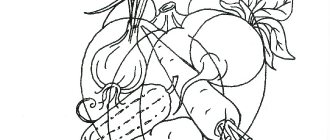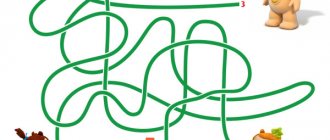Mnemonics for beginners is a system of various methods that helps to remember information using various associations and is used in teaching children from preschool age. This technique uses previously acquired knowledge to create a chain of connections. Thanks to such logical series, you can easily remember information that is difficult to perceive.
There are many mnemonic techniques. For example, Cicero’s method is based on spatial imagination, while Aivazovsky’s method works by training visual memory. Number sequences, foreign words or complex terms are easier to remember with the help of consonant or familiar words and numbers.
In a time when there was no written language, ancient priests and storytellers had to memorize enormous amounts of information. With the advent of the first texts put on paper, the art of using mnemonics did not lose its relevance, because the raw materials for writing them were very expensive. Even in Ancient Greece, notes were made using mnemonics. The art of associative memorization was mastered by the monks of the Middle Ages. At all times, people who could quickly remember and store useful and interesting knowledge in their heads were valued.
Pros and cons of mnemonics
Mnemonics are actively used in teaching children. For example, one of the most famous phrases for studying the sequence in the color spectrum is “Every Hunter Wants to Know Where the Pheasant Sits.” It is she who helps to accurately tell how a rainbow “works.”
The role of methodology in the development of children:
- helps you remember information quickly and for a long time;
- improves memory and attentiveness;
- develops speech, expands vocabulary and horizons, teaches how to pronounce sounds and words correctly;
- forms logical and imaginative thinking;
- improves imagination, intellectual and creative abilities;
- develops character, teaches sociability, helps to overcome isolation and shyness.
When used correctly, mnemonics have very few disadvantages.
- At the initial stage of use, children have a small vocabulary, so it can be difficult for them to work using this method.
- There is no need to abuse the method and use it in cases where it is too easy to understand the properties and remember the signs - this hinders the child’s development.
- Sometimes it is not possible to use the technique. For all-round development, it is necessary to teach the child to learn information mechanically; this skill will also be useful in the future.
The human brain consists of two hemispheres. The left is responsible for logic and speech, and the right helps to perceive different colors and form images using the imagination. When using mnemonic techniques, both halves are activated simultaneously. As a result, thought processes bring maximum benefit in the form of acquired knowledge.
Methods
Since mnemonics did not appear yesterday, it includes various techniques, each of which offers the use of its own methods of memorizing information and memory training. Beginners may find them too complicated. In fact, if you understand their algorithm and master at least one, it will greatly simplify your life. We bring to your attention some of the most famous mnemonic systems.
Alphanumeric alphabet
The abbreviated name is CBA. Author unknown.
A technique according to which each number is associated with a specific letter through visual or auditory association. There are clearly written alphabets that need to be memorized and put into practice. You can create your own.
Alphanumeric code
The abbreviated name is BCC. The author is V. Kozarenko, a well-known specialist in mnemonics, who has written many textbooks on it.
The system of memorization and memory development proposed by Kozarenko is similar to the previous one. But here, first you just need to memorize the correspondence between numbers and paired consonant letters without any associations, and then use them in life. His BCC looks like this:
- 0 — m/n;
- 1 - g/f;
- 2 - d/t;
- 3 - farm;
- 4 - h/sh;
- 5 — p/b;
- 6 - sh/l;
- 7 — s/z;
- 8 - v/f;
- 9 - r/ts.
How to use. For example, you keep track of your income and expenses, you spent 2,056 rubles in a store, and you need to remember it in order to record it at home. You come up with a word that has a consonant corresponding to each number, and make a sentence out of them. 2 - children, 0 - ice cream, 5 - ice cream, 6 - chocolate. The children ate ice cream, it was ice cream and chocolate. There is no need to set a goal to come up with something conscious and logical. The more unusual the phrase, the better it will be remembered.
Other methods are also used in mnemonics:
- Fractional Number Code (FNC) - for those who deal with mathematics.
- Development of visual memory through visual associations. For example, each line of a memorized poem (a number in a formula) is “nailed” on a particular house (or tree) on the way to work or to the store and is repeated every time you walk along it.
- Method of auxiliary objects: if you put your finger on the Moon, you can understand whether it is growing or aging, depending on the resulting letter (P or S).
- Development of sound memory: chants (for learning Morse code), rhymes (“One Hundred Chinese Surnames”, Perelman’s dialogue about circles for memorizing the number Pi).
There are a large number of memory systems in mnemonics. You need to choose what suits you. If you have nothing to do with mathematics, KDC and Perelman’s dialogue are of no use to you. Look for those techniques that are relevant specifically to your life. Also focus on your memory type. You can first begin to perfect the one that prevails in you, and then develop the one that is worse.
From what age is it used?
Teaching children using mnemonics can begin from a very early age. Getting to know exercises for children starts with simple techniques.
First, they use mnemonic squares, which can be introduced to children at the age of three. In the first lessons, children study simple images that represent one word, phrase or simple phrase. You can place pictures in a square and learn poems with movements.
Later, at 4-5 years old, children become familiar with mnemonic tracks - systematized pictures of four drawings. With the help of such images, the concept of sequences is formed. Thanks to group illustrations, you can easily tell a short story, remember the steps of washing your hands, the process of dressing or washing your face.
Children aged 6-7 years begin to study mnemonic tables that allow them to perform more complex actions:
- retell various works;
- memorize poems and complex words;
- guess and make riddles;
- find rhymes for words;
- invent fairy tales or stories;
- distribute objects into groups according to certain characteristics;
- study numbers;
- become familiar with the basic rules of life safety and behavior in various places, and methods of self-service.
Children learn to express their thoughts correctly and beautifully and use new words in speech. Attention and intelligence develop, the ability to highlight the main thing and compare improves.
Kinds
If you plan to use mnemonics, keep one important point in mind. This is a whole science that has developed over several centuries. It has a rich history of development and there are many directions in it. In the same books dedicated to this art, they are often intertwined with each other. The authors offer sets of exercises, some of which relate to folk techniques, others to the classics. Such heterogeneity leads to the absence of a system.
Don't step on this rake. Choose one of the areas in accordance with your goals, objectives and individual characteristics and master it first. If things go well, then continue practicing using a different method.
Folk
The techniques of folk mnemonics are familiar to most people, as they have become firmly established in their lives, and many do not even suspect it. These are those rhymes with exceptions to the rules that they learned at school, the phrase about the hunter and the pheasant with the colors of the rainbow that set the teeth on edge. Road signs on the street, symbols on a computer desktop, the alphabet - these are all codes for developing memory in order to better remember and reproduce the necessary information faster.
Acrostic
Someone comes up with their own systems for learning a foreign language or chemical reactions, telephone numbers or significant dates - all this reflects the essence of everyday, or folk, mnemonics.
Classical
This is the very first system of mnemonics that has come down to us in written form. It dates back to 86 BC. e. At that time it was an integral part of rhetoric. Speakers used it to deliver long speeches accurately and without hesitation.
One of the most striking examples is Cicero's method. His opponent was Quintilian; he advocated for those people who had poorly developed visual and associative memory and who could not use Cicero’s technique. Quintilian proposed other alternatives to storing information, but was unable to formalize them into a separate system. However, it was they who later became the basis for the development of pedagogical mnemonics.
Pedagogical
The antipode of classical mnemonics. It finally took shape only in the 16th century, thanks to the Cambridge University teacher P. Ramus. This direction was closer to ordinary people, so it became widespread. There was no need to make complex visual associations here. Her main techniques were:
- repeated reading of the text and repeating it out loud;
- taking notes;
- redrawing illustrations;
- play activities;
- creation of didactics.
Methods of pedagogical mnemonics are still used in the modern education system.
Circus
The second name is variety. A narrow circle of people (it all started with circus troupes) creates its own system for coding the material. Anything can be used: language, gestures, facial expressions, intonation. The task is to transfer information from the assistant to the performer so cunningly that no one notices. These techniques are now actively used by scammers, telepaths, and psychics.
Sports
Since 1997, mnemonics competitions have been held annually in Cambridge. This direction has special specifics. Each participant is a guru in a specific area. Some reproduce binary numbers from memory, others recite poems 300 pages long by heart. As a rule, the winners end up in the Guinness Book of Records. The best in their field are determined by two indicators: memorization speed and volume.
Modern
The main representative of this direction is the Giordano mnemonic system. It is quite complex, based on scientific research in neurobiology about the brain and memory as a higher mental function. Here are just some of its provisions:
- development of electrical (neural) memory;
- mental operation “Connecting images”;
- the concepts of “Memorization Meaning” and “Accurate Information”;
- associations consisting of a foundation and auxiliary elements;
- system of internal stimulation of the cerebral hemispheres;
- multi-level schemes of reference images;
- constant training of memorization skills.
Mnemonic rule for remembering the number of days in a month using your knuckles
Don't remember what happened 5 minutes ago? Our short-term memory is to blame for this. What it is and ways to improve it is in our separate article.
Features of application
You can achieve results during mnemonics classes if you follow the basic rules for using the technique.
- Subsequence. You cannot start classes with difficult tasks. First they work with mnemonic squares, single images, then with mnemonic tracks and mnemonic tables.
- Rationing. Children are not shown more than two tables per day, and the number of images in each block should be no more than 9 pieces. Too much information is difficult for a child to absorb, so classes will be ineffective.
- Colorfulness. The pictures should interest the child in their appearance. They use bright colors, rich and expressive images. Tables in black and white will not be able to attract the attention of children and have the desired impact; they can only be used for children of older preschool age.
- Emotionality. Children should feel the positive energy of such activities.
- Diversity. Pictures or series of images for one lesson should be on different topics. Guys will quickly lose interest in the same type of training. It is also advisable to select tables that require different actions. For example, the first pictures help to remember the sequence of food intake, and the next group helps to tell about how insects move.
- No coercive measures: just a game. Classes can only be conducted when children are involved in the process with pleasure and interest. Everything should happen in a playful way. If the children's attention wanes, it is better to stop the lesson and continue at another time.
It is enough to adhere to these simple principles to achieve maximum learning results.
Definition
Mnemonics (mnemonics) is a list of methods and techniques that help remember various types of information.
Mnemonics is based on the principle of visualizing abstract objects, which are replaced by specific concepts or figurative definitions. To easily and quickly memorize the necessary information, you need to associatively associate it with some visual idea, sound image or sensation. Associations - establishing connections with known images and phenomena.
Mnemonic tables for composing stories
At the beginning of the lesson with mnemonic tables, the teacher invites the children to carefully examine all the drawings and talk about what they saw. Then the adult deciphers the table in detail and composes an interesting story for the children.
For example: “Autumn has come. The sun began to warm less, all the animals in the forest began to prepare for winter. The squirrel has prepared a lot of nuts, which she hides in her house on the Christmas tree. The bunny changed his gray fur coat to a white one so that he would not be visible in the snow. And the big brown bear is preparing a den for himself, in which he will sleep until spring. The bear will not freeze, because the fallen snow will cover the bear’s house like a blanket. So the bear will sleep until spring.”
Next, the teacher invites the kids to reproduce the entire story, looking at the pictures. This technique is successfully used not only in older groups of preschool educational institutions, but also in speech therapy for speech development, correcting incorrect pronunciation and in the treatment of stuttering in preschoolers.
Basic rules for conducting classes
- Class notes must be taken.
- Work begins with simple mnemonic squares, then mnemonic chains are introduced. When the child understands the essence of the tasks, you can move on to mnemonic tables.
- All drawings must be color, clear and understandable.
- The number of squares in the table should not be more than nine. This is the maximum allowable amount of visual information for a preschooler.
- No more than two mnemonic tables are used in one lesson. Re-examination or work with them can only be done at the request of the child.
- Every day the tables and assignments change by topic. At the beginning of the lesson, you can review diagrams of past lessons, repeat a learned poem or story.
- In older groups of preschool educational institutions, children should be encouraged to draw tables themselves based on the teacher’s story or based on their own invented stories.
It is very important that parents also become familiar with this technique and take an active part in the development of the child. According to the observations of child psychologists, children who work with associative schemes adapt faster at school, their perseverance, concentration and communication abilities are well developed.











